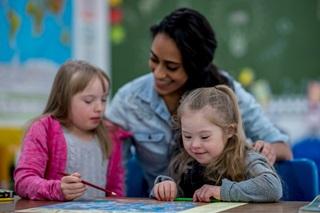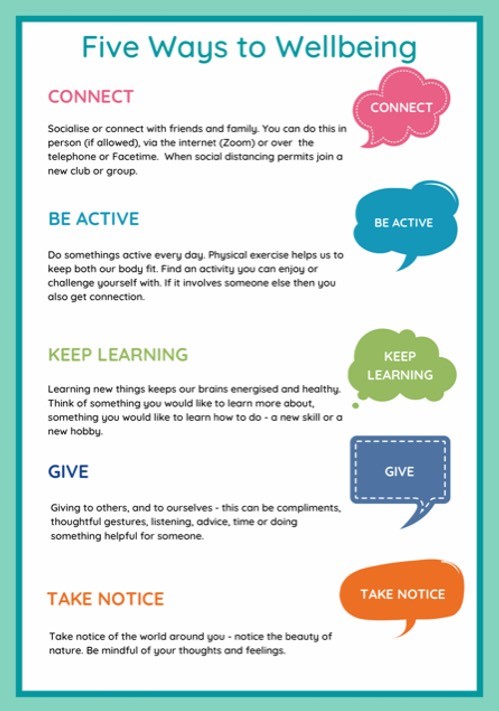Five to Thrive encourages secure attachments between caregivers and children to ensure positive brain development to support a child’s emotional resilience and communication skills.
It's demonstrated in a tower of building blocks and gives ideas on how parents and caregivers can be responsive to their children through five key principles (the blocks) - respond, cuddle, relax, play and talk

Five to Thrive for babies
You can find more information to support the health and wellbeing of you baby (0-5) at Health for Under Fives
Five to Thrive for toddlers
You can find more information to support the health and wellbeing of you baby (0-5) at Health for Under Fives
Five to Thrive for primary school age
You can find more information to support your little ones health and wellbeing at Healthy Together including school nurse services.
Five to Thrive for secondary school age
You can find more information to support your teenagers health and wellbeing on our Teen Health site (Leicestershire residents ) or Health for Teens (Leicester City residents)
Five to Thrive young adult (neurodiverse)
You can find more information to support your teenagers health and wellbeing on our Teen Health site (Leicestershire residents ) or Health for Teens (Leicester City residents)
Alternatively, take a look at our SEND page for more details on the help available.
The Building Blocks
Respond

Responding happens when the parent/carer is emotionally available to the child and recognises the child needs you to help them regulate how they're feeling
Your child will experiences a sense of safety and belonging if you respond to their needs.
For example
- When a baby cries you pick them up
- When you notice your teenage isn't feeling themself

If your child doesn't experience a parent/carer's response, they may
- Struggle understanding their identity
- Have bonding difficulties
- Attention seek
- Struggle with understanding feeling safe
- Show controlling behaviour
- Find it difficult to be dependent/independent
Things to try

Engage (Cuddle)

Engage is when you make a positive connection with your child. For younger children, we use the word cuddle. You can cuddle them as often as you like – babies cant have too much contact. Nurturing contact or comforting a distressed infant restores balance in the baby’s brain and body
If your child doesn't experience a close connection to their parent/carer's , they may
- Have difficulty recognising feelings in self or others
- Lack motivation for social interaction
- Find it hard to show their feelings and understand others
- Find it challenging to explain their feelings using words
Things to try at home
- Set up a cuddle corners (comfy cushions, mood lighting) story corner (books and puppets) or role play corner (hairdressers brushing hair) Sitting on laps and positive touch through reading and nursery rhymes (round and round the garden) is a great fun way to do this.

- Baby massage after bath time or nappy change. Babies need cuddle and touch that soothes them and stimulates them
- Gently stroking your child after nap time or in the morning to wake them up
Remember - Respect the personal space of your child as they grow – they may not want a hug but you can find other ways to provide reassuring contact

Relax

Being able to relax (or stay relaxed) in a difficult situation is key to learning how to be resilient.
Its useful to think of who your support network is , so you know who to ask for help when your feeling overwhelmed.
If your child is feeling stressed, they may
- Difficulty staying calm (regulating their stress levels) which can show as rage, panic, anger and disconnection
- Have a reduced attention span and poor concentration
- Appear switched off and have reduced awareness
Things you can try at home
As a parent/carer, the 5 ways to wellbeing is a useful guide to give yourself a boost. Checkout what activities are on in your local area. Wellbeing Cafes (at select Family Hubs), Buggy Walks and local parks are a safe space to help regulate stress. You can find more information on the Active Together website

For your child, calming activities are a really good way to help them relax.
Sensory play (fidget toys for older children) is a great place to start. Its a myth that this has to be expensive.

Why not make sensory glitter bottles at home with a used water bottle, glitter, pom poms and beads. This is a really low cost way to engage your babies senses.
Play

Playing and being playful is really important to your child's development. It give parents/carers the opportunity to have fun and communicate in lots of different ways. Being playful in a challenging situation like a tantrum through non-verbal actions (smiling, touch, facial expressions to show acknowledgement) can help diffuse the situation, but also show you understand how they are feeling.
If a child doesn't learn how to play and be playful, they may
- Be unable to take turns or share
- Struggle to manage their impulses
- Be unable to take accountability for their actions
- Find praise and criticism hard to take
- not be able to benefit from rewards/sanction
Things to try at home
- Parents/carers can practise playfulness at home, as this may not come naturally. Take note of your facial expressions, body language and tone of voice
- Toys/games that require you to take it in turns is a great way to role model sharing, rules, empathy and patience

- Children enjoy spending time with you, you don't need to spend money on toys and crafts. You are their favourite activity.

Talk

The last block in the tower is Talk, and this cover all sorts of verbal communication such as explaining, describing, asking, chatting, signing and singing
Your baby loves the sound of your voice. When you talk to your baby you are laying down patterns and rhythms in their brain. This will help your baby to become verbal and connected. It is important to involve your baby in what’s going on by telling them about it. Try to chat about what you are doing in your daily routines, for example by saying “Let’s change your nappy”. This helps them to link words to activities.
- Making eye contact with your baby will help to keep their attention
- Get their attention, use their name
- Speaking clearly and slowly will help them to pick out words
- Be interesting and vary the tone of your voice and facial expressions
- Try not to be self-conscious
- Talk to your child to reassure them
- Listen to your baby’s noises and talk back to them
- Sing nursery rhymes
- Talk to your baby to reassure them

Talk to toddlers to give them words to express themselves, they can be easily distracted at this age, that’s OK. You are more likely to hold their attention if you make some funny sounds like animal noises and if you vary the tone of your voice.
As your child gets older, it is good to talk to them about their:
- Feelings
- Emotions
- Actions
- Mind connections
- Body connections
This will help them problem solve.
If your child is not behaving how you’d like them to behave, tell them what you would like to see them doing instead of what you do not want them to do. This will help them to understand. When you and your child are both calm you can talk about what happened:
- Name the behaviour
- Name the emotion your child was feeling
- Talk about and agree what your child could do differently next time

Books and stories
It’s great if you have some props like puppets to bring stories to life. You don’t need anything fancy as you can make a sock puppet with an old sock and a couple of buttons. Faces on wooden spoons are also fun.
Different family members may be reading the same books to your child. Adults all tend to read books differently and this variety is good for your child. You may:
- Focus on different words
- Say things differently
- Pay attention to different parts of the story
- Use different voices for characters

Further information
Why does my child become stressed ?
When a child has a building block(s) missing, they will be experiencing stress and tension.
This poem is a really good way of explaining why our children sometimes get dis-regulated and a useful tool to help older children understand their emotions
When your child is upset, you can also follow the Five to Thrive blocks to help you handle the situation calmly and positively. You can do this by following the blocks in sequence from bottom to top.
RESPOND – acknowledging their needs
ENGAGE – enabling the other person to connect with you
What can I do to support my child if they are stressed
The Five to Thrive approach is built on positive, responsive parenting which expresses unconditional love and support. Following the building blocks everyday will help you to do this and reduce stressful moments.
But in addition to this, its important to keep your wellbeing as a priority too.

Studies have also shown that the following experiences help children feel secure and positively challenged
Did you know you can use our handy What's on Guide to see what groups, hobbies and activities are available in your local area.
Useful resources you can print at home
Here's some resources you can use at home to help you on your Five to Thrive journey
- Parents Journal
This handy journal can be used to keep track of what Five to Thrive experiences you notice everyday. Also, its a great place to keep notes of activities you want to try or events to go to.
- Red Book (babies personal health record) insert (printable)
You can print off this Five to Thrive insert and add it to your Red Book as a Five to thrive reminder
- One page profile for 11+
This handy one pager is perfect for young adults to write down their thoughts and feelings to help open up during conversation with a trusted adult
What you need to know about screentime
Often, when we're feeling exhausted we give in to the temptation to give our children extra screen time using tablets and mobile phones. Although this can bring much needed peace and quiet, it does effect a child's brain development.
Five to Thrive explains how connected relationships help build brain connections creating a sense of safety and belonging.
Take a look at the Five to Thrive page and the Relax block to for other ideas to create a calm space.
Take a look at the Tiny Happy People website for a collection of tips on how to manage screen time effectively to support speech and language development, build connections and use it as a tool for healthy brain development